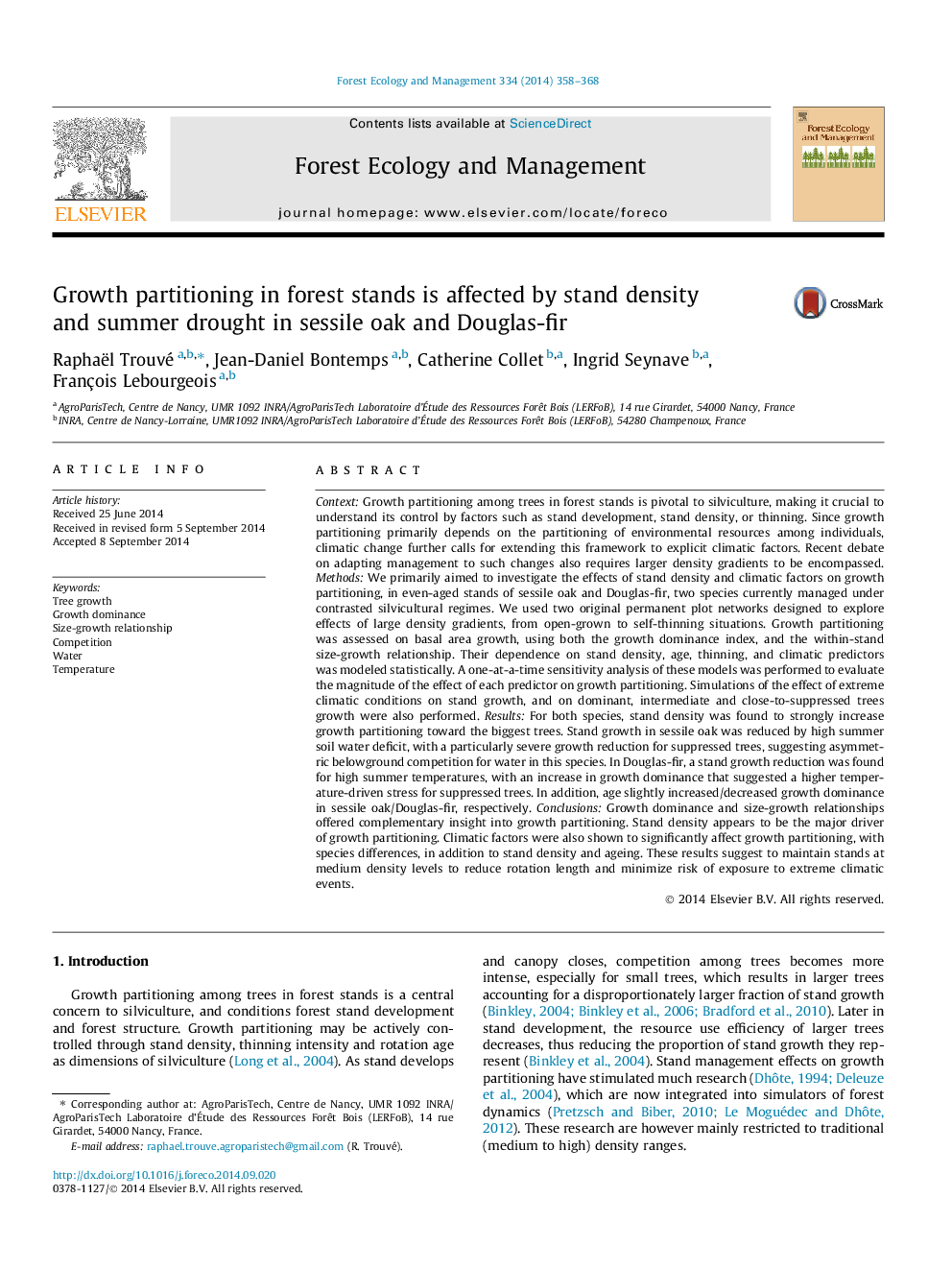| کد مقاله | کد نشریه | سال انتشار | مقاله انگلیسی | نسخه تمام متن |
|---|---|---|---|---|
| 6543193 | 159186 | 2014 | 11 صفحه PDF | دانلود رایگان |
عنوان انگلیسی مقاله ISI
Growth partitioning in forest stands is affected by stand density and summer drought in sessile oak and Douglas-fir
ترجمه فارسی عنوان
پراکندگی رشد در جنگلها تحت تأثیر تراکم پایدار و خشکی تابستان در بلوط سرسبز و کوه داگلاس
دانلود مقاله + سفارش ترجمه
دانلود مقاله ISI انگلیسی
رایگان برای ایرانیان
کلمات کلیدی
رشد درخت، سلطه رشد، رابطه رشد اندازه و رشد، رقابت، اب، درجه حرارت،
موضوعات مرتبط
علوم زیستی و بیوفناوری
علوم کشاورزی و بیولوژیک
بوم شناسی، تکامل، رفتار و سامانه شناسی
چکیده انگلیسی
Context: Growth partitioning among trees in forest stands is pivotal to silviculture, making it crucial to understand its control by factors such as stand development, stand density, or thinning. Since growth partitioning primarily depends on the partitioning of environmental resources among individuals, climatic change further calls for extending this framework to explicit climatic factors. Recent debate on adapting management to such changes also requires larger density gradients to be encompassed. Methods: We primarily aimed to investigate the effects of stand density and climatic factors on growth partitioning, in even-aged stands of sessile oak and Douglas-fir, two species currently managed under contrasted silvicultural regimes. We used two original permanent plot networks designed to explore effects of large density gradients, from open-grown to self-thinning situations. Growth partitioning was assessed on basal area growth, using both the growth dominance index, and the within-stand size-growth relationship. Their dependence on stand density, age, thinning, and climatic predictors was modeled statistically. A one-at-a-time sensitivity analysis of these models was performed to evaluate the magnitude of the effect of each predictor on growth partitioning. Simulations of the effect of extreme climatic conditions on stand growth, and on dominant, intermediate and close-to-suppressed trees growth were also performed. Results: For both species, stand density was found to strongly increase growth partitioning toward the biggest trees. Stand growth in sessile oak was reduced by high summer soil water deficit, with a particularly severe growth reduction for suppressed trees, suggesting asymmetric belowground competition for water in this species. In Douglas-fir, a stand growth reduction was found for high summer temperatures, with an increase in growth dominance that suggested a higher temperature-driven stress for suppressed trees. In addition, age slightly increased/decreased growth dominance in sessile oak/Douglas-fir, respectively. Conclusions: Growth dominance and size-growth relationships offered complementary insight into growth partitioning. Stand density appears to be the major driver of growth partitioning. Climatic factors were also shown to significantly affect growth partitioning, with species differences, in addition to stand density and ageing. These results suggest to maintain stands at medium density levels to reduce rotation length and minimize risk of exposure to extreme climatic events.
ناشر
Database: Elsevier - ScienceDirect (ساینس دایرکت)
Journal: Forest Ecology and Management - Volume 334, 15 December 2014, Pages 358-368
Journal: Forest Ecology and Management - Volume 334, 15 December 2014, Pages 358-368
نویسندگان
Raphaël Trouvé, Jean-Daniel Bontemps, Catherine Collet, Ingrid Seynave, François Lebourgeois,
